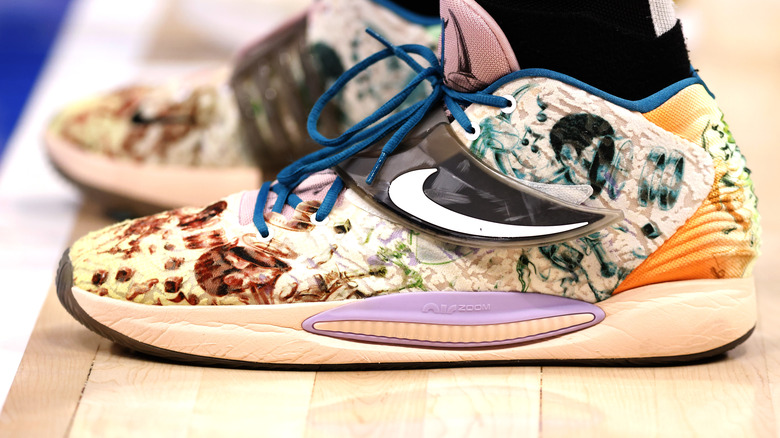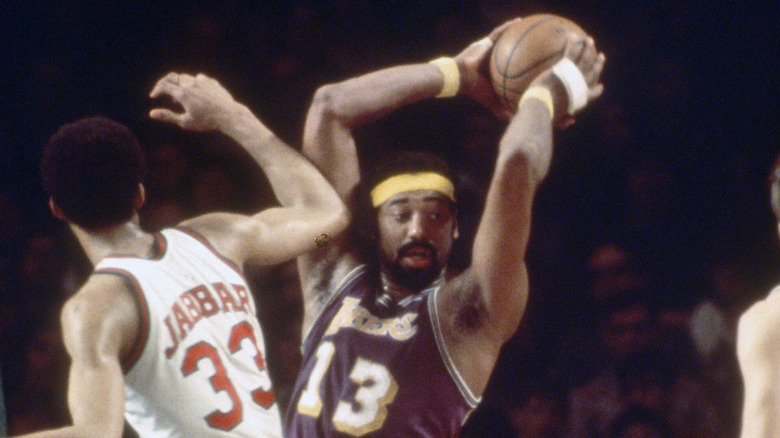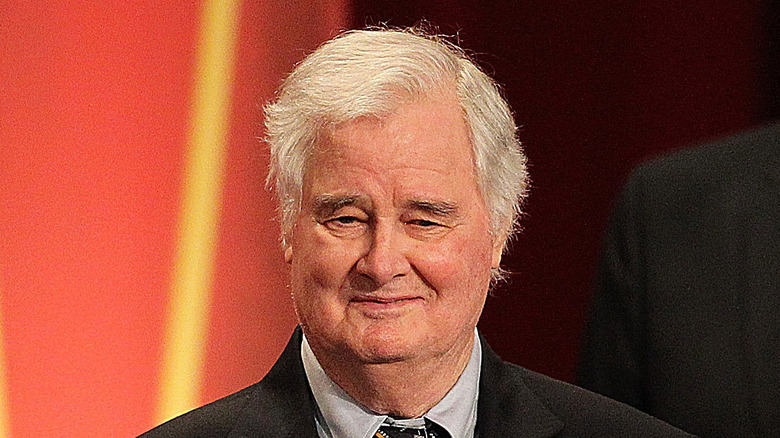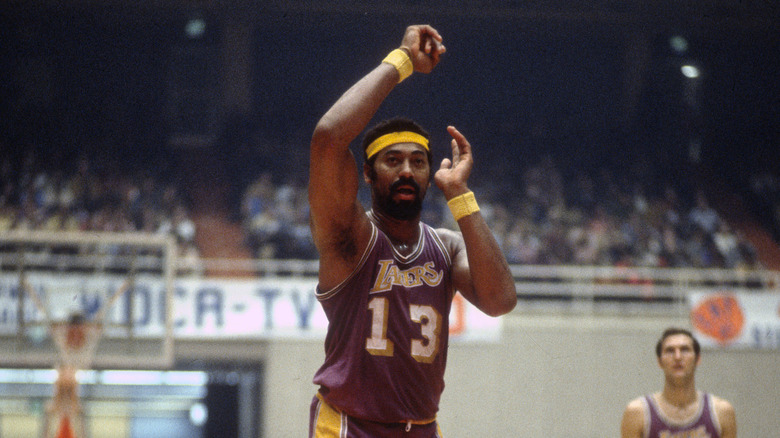Here's Why You're Not Allowed To Dunk From The Free-Throw Line
On the surface, it's among the easiest shots anyone can take in basketball. You're standing 15 feet away from the basket, with no hand in your face or making its way to the ball. All you need is the right shooting stroke, a smooth rhythm, and calm nerves, and you've got a fairly good chance of sinking the shot. Unfortunately, shooting a free throw isn't always that simple, as there are players (Shaquille O'Neal, Dwight Howard, and Ben Simmons, among many others) who, talented as they are, have (or had) difficulty converting on their attempts from the charity stripe. Wouldn't it be so much easier if you could just dunk from the free-throw line, provided you've got the athleticism to pull off such a feat? Julius Erving and Michael Jordan did it in the dunk contests, so if you've got the hangtime, why not do it in a regular game?
The bottom line is that the NBA and NCAA both have rules that prevent players from engaging in such feats of athleticism. The simplest way to explain these rules is to say that allowing players, especially those notoriously bad free-throw shooters, to jam it in from the 15-foot line would make it too easy. But there's a much more detailed explanation behind it all, and much of it has to do with one man, a true basketball legend who could do practically anything on the court — except consistently convert on his free throw attempts.
Wilt Chamberlain started dunking from the foul line in high school
If you guessed that the player we were referring to above was Wilt Chamberlain, then you're absolutely right. He remains the only player in NBA history to score 100 points in a game, was a fearsome rebounder and defender in his own right, and it's been said that he was so fed up with being labeled as selfish that he started passing the ball like a point guard, becoming the only NBA center to lead the league in assists in the process. There was, however, one thing he couldn't do, and that was shoot better than 63% from the free-throw line — his highest percentage in a college or pro basketball season, per his Basketball-Reference player page.
In addition to being a phenomenal player on the court, Chamberlain was also a fantastic athlete, and while he was attending Overbrook High School in Philadelphia, he reportedly came up with a novel solution to his free-throw shooting problem. Speaking to The Philadelphia Inquirer, Chamberlain's former Overbrook teammate, Mel Brodsky, recalled that there were a few times the would-be "Big Dipper" would occasionally fool around during practice and dunk from the foul line, but also made sure to note that Chamberlain never tried it in an actual high school game.
The NCAA gets tough on Chamberlain
He's best known these days as the architect of the triangle offense, but back in the 1950s, Tex Winter (pictured above in 2011) was the young head coach of the Kansas State Wildcats basketball team, and a man who knew the NCAA might have a problem on its hands if it allowed this Wilt Chamberlain kid from in-state rival Kansas to dunk from the free-throw line. Per The Philadelphia Inquirer, the only time Chamberlain dunked from the stripe in a public setting was in December 1955 during the annual scrimmage between the Jayhawks' varsity team and freshman squad. Winter was at the event, and he was concerned that Chamberlain's Jayhawks could potentially dominate his Wildcats if he was allowed to dunk in his free throws. He also had the authority to suggest changes to the NCAA's basketball rulebook.
"I was the chairman of the Coaches Rules Recommendation Committee," Winter said in 2011, explaining how he made his case against Chamberlain at the 1956 NCAA coaches' convention. "I explained to the coaches at the convention what I saw and said something's got to be done." Winter got the support he was hoping for, with Southern Methodist University's coach, Doc Hayes, telling reporters that dunking free throws was tantamount to "cheating."
During the meeting, a number of rules were instituted to prevent big men like the 7-foot-1-inch Chamberlain from taking over college basketball, and one of them was the ban on free-throw-line dunking. At that time, freshmen were still not allowed to play varsity basketball in the NCAA, so Chamberlain was essentially prohibited from using the ultimate workaround for his notoriously poor foul shooting even before his college career officially began.
The NBA only followed the NCAA's lead after Chamberlain turned pro
The current NBA rulebook states that "the free throw shooter may not step over the plane of the free-throw line until the ball touches the basket ring, backboard or the free throw ends." This, in and of itself, effectively outlaws dunking from the foul line, and it should come as no surprise to anyone that the rule was only implemented after Wilt Chamberlain entered the NBA in 1959.
During his rookie season with the Philadelphia (later Golden State) Warriors, Chamberlain converted on 58.2% of his free throw attempts — that's nothing to write home about, but still well above his 51.1% career average. However, Chamberlain's free-throw shooting as a rookie, according to this episode of Secret Base's "Weird Rules" YouTube series, was nonetheless poor enough to merit a news report where he and his coach, former Warriors star center Neil Johnston, were quoted as saying that Chamberlain won't dunk in his free throws even if he could. As explained, the mere thought of Chamberlain potentially dunking from the 15-foot line drew the attention of Jocko Collins, then the supervisor of the NBA's team of officials, who banned free-throw-line dunks on the same day the article was published.
So if you're wondering why the free-throw-line slam is only seen in dunk contests and not from bricklaying high-flyers in actual games, you've got Tex Winter and Jocko Collins to thank ... or blame for all that.



